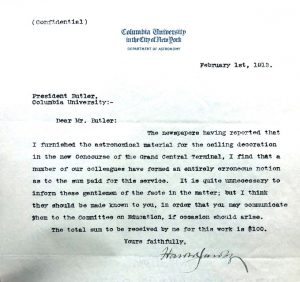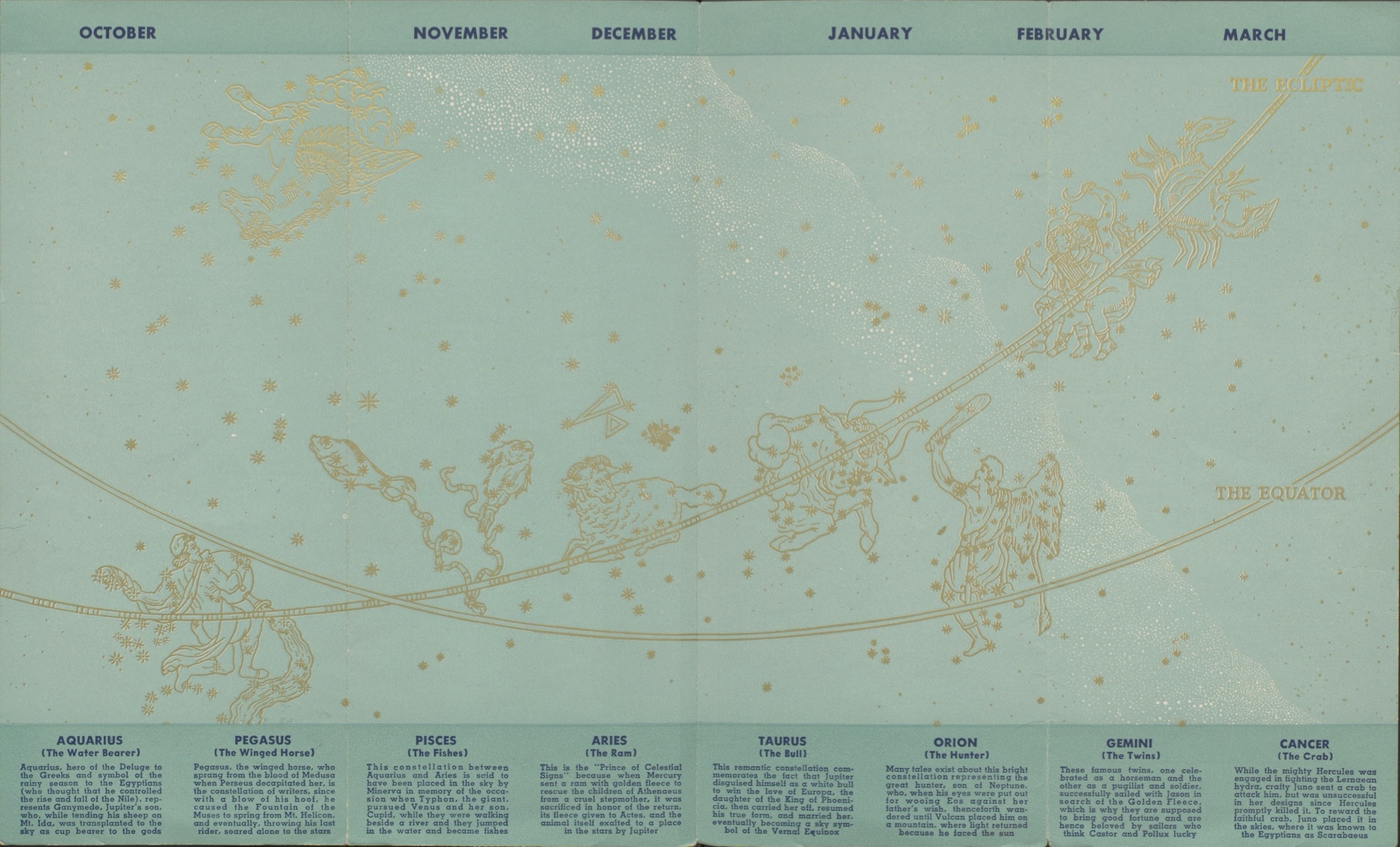The new skylight ceiling of the recently opened Moynihan Train Hall, the expansion of Penn Station, recalls the 1913 opening of Grand Central Terminal and its own celestial ceiling. Above the main concourse, the vaulted ceiling features an expansive mural of stars and constellations, thanks to the expertise of Columbia astronomy professor Harold Jacoby.
The architectural firm of Warren & Wetmore had originally planned a skylight for the concourse ceiling but later had to reconceive their plan. For their starry new vision, Columbia University professor of astronomy Harold Jacoby, in his words, “furnished the astronomical material for the ceiling decoration,” [[1]] and the artwork was done by Charles Basing (Hewitt-Basing Studio) and artist Paul Helleu, who came up with the idea to use lights for some of the stars. Jacoby’s contribution was key: he provided the celestial map of what is visible above Grand Central from October to March and the source of the illustrations, Johann Bayer’s Uranometria.

Johann Bayer (1572-1625) was a lawyer and amateur astronomer who lived in the city of Augsburg, Germany. He first published this celestial atlas in 1609. The work includes the 48 Ptolemaic constellations: one engraving per constellation, with each star labeled with a lower-case Greek letter. (In fact, this use of letters to identify the individual stars that make up a constellation is still called Bayer designations.) Not only were the illustrations memorable, but most importantly, the drawings were scientifically accurate. As such, Bayer’s Uranometria became the standard celestial atlas for the 17th and 18th centuries. The work became so popular and was reprinted so frequently, that by 1661 the engraved plates had to be retouched to restore the clarity of the impressions.
Jacoby had not just one but two copies of Bayer’s standard reference work available to choose from at the Columbia Library. The first copy of the Uranometria came to the Library as a gift by the Alumni Association of Columbia College in 1879. The alumni came together to purchase the library of the late Henry James Anderson (1799-1875). Anderson graduated from Columbia College in 1818 and from the College of Physicians and Surgeons in 1824. He served as the professor of mathematics and astronomy (1825-1843) and later as a trustee (1851-1875). His book collection included about 1,300 mathematical and scientific volumes and was purchased for $1,500. This Uranometria was printed in 1639 and the affixed bookplate states “From Dr. Anderson’s Collection, Given by the Alumni.” A second copy of the Uranometria was purchased in 1900. In this later edition, illustrations are printed over two pages, instead of one image per page.

In 1913, the opening of the new Grand Central Station fittingly received much media attention and Jacoby’s name and role were featured prominently in the papers. Perhaps drawing too much attention, on the day before the official opening (February 1), Jacoby wrote to President Nicholas Murray Butler to clarify his involvement with the project. He wanted the Trustees’ Committee on Education to know that this was not ‘other employment’ (something prohibited by the University statute 66) and “the total sum to be received by me for this work is $100.” [[2]]
Unfortunately, a month after the opening of the new Grand Central, a commuter pointed out a crucial error: the celestial map was backwards. Jacoby’s work had been projected onto the ceiling and in doing so, the image had been inadvertently reversed by the painters. (Compare Aries in Bayer’s Uranometria above and the Aries in the 1930s Grand Central Station pamphlet below.) Only the pamphlets and postcards printed before the opening of the station rendered Jacoby’s contribution correctly.

[[1]] and [[2]] Harold Jacoby to President Nicholas Murray Butler, February 1, 1913. Central Files (Box 328, Folder 21), University Archives.